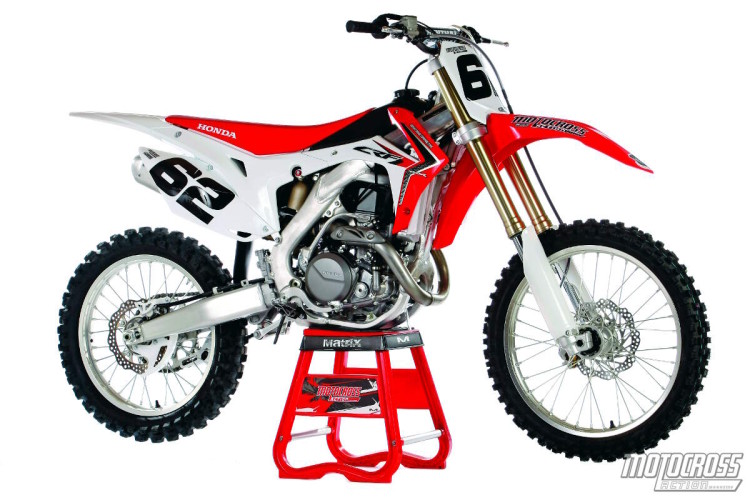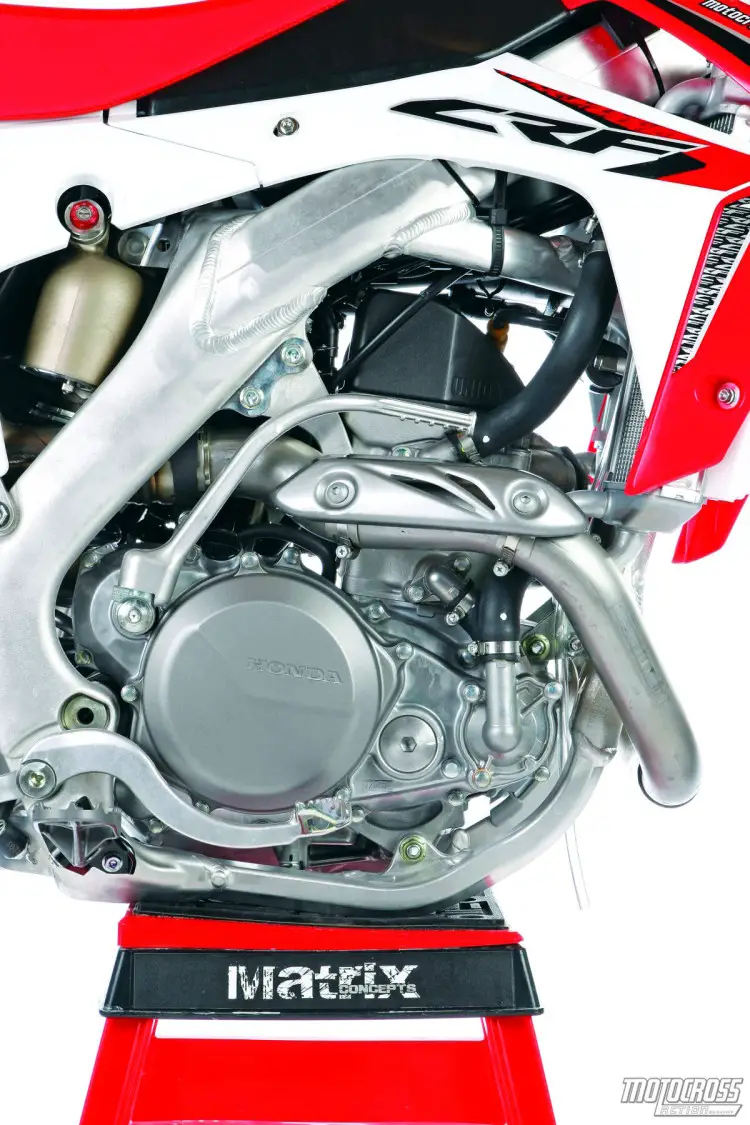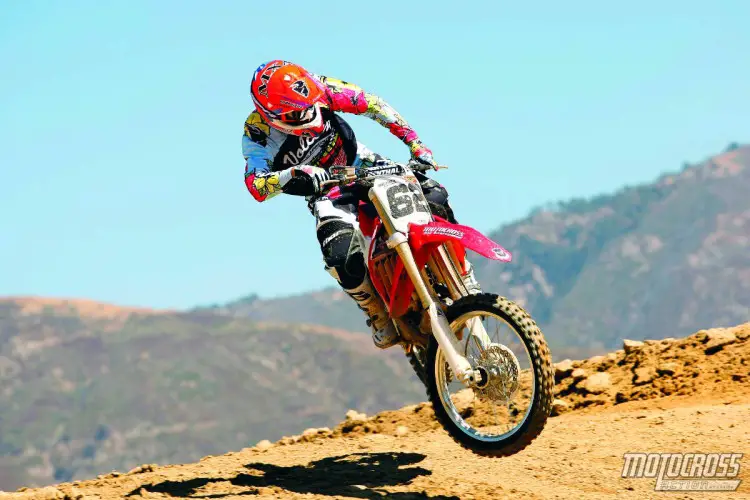2014 HEAVY-HITTER REMATCH: KX450F VS. CRF450
IF MONEY IS NO OBJECT, IF OVERALL PERFORMANCE MATTERS MORE THAN SOCIAL STATUS, AND IF YOUR DREAM BIKE IS A KAWASAKI ENGINE WITH YAMAHA SUSPENSION, SUZUKI CORNERING AND KTM BRAKES, YOU JUST FELL THROUGH THE RABBIT HOLE.

Modern motocross bikes are very good, but none of them combine the best features of your dream list. And, as the MXA wrecking crew has found out many times, even if you poach the parts off one bike and graft them to another, the magic doesn’t come along for the ride. Nope! The best you can hope for is to read bike tests, technical articles and shootouts (ours, not the other guys’), and try to make compromises where you think your talent can afford them. To that end, the MXA gang decided to take the 2014 MXA 450 shootout winner, the Kawasaki KX450F, and compare it head to head against the 2014 MXA 450 shootout loser, the Honda CRF450.
Despite the brilliance of this idea, there are some major shortcomings. Most obvious is the fact that the MXA test riders spent seven months racing, testing, riding and evaluating these two bikes—and we already made up our minds. The KX450F was first and the CRF450 was fifth. The facts haven’t changed, but the mindset has.
For the rematch, we aren’t choosing the ultimate expression of moto dominance, but rather parsing the parts, peccadilloes and pleasantries of both machines. Unlike our typical shootout, we staked out an opinion-free zone and set the goal of having each bike knock our socks off with what it does best. In this case, we aren’t necessarily letting the best man win!
ALTHOUGH THE 55.05-HORSEPOWER KAWASAKI KX450F ECLIPSES THE 51.94-HORSEPOWER HONDA CRF450 BY ALMOST 4 HORSEPOWER, THE MELLOW CRF IS ACTUALLY QUITE CHARMING TO RIDE.

The CRF450 has an obliging powerband and doesn’t stress the rider with its abundance, but instead invites him to use more of what’s available. Throttle response down low is shockingly good. The CRF450 surfs the low-to-mid transition with an amazingly snappy sense of urgency. From off idle to 6400 rpm, the CRF450 has no match—not from the ultra-powerful KX450F, the RM-Z450, the KTM 450SXF or the YZ450F. It has power now! And even though this isn’t an rpm range that wins shootouts, it is a zone that gets the CRF450 out of corners and up on the pipe with a lightning-like spark.
This one snappy trait is embedded in the DNA of the Honda, because what happens after this, in what everyone would call the “meat of the powerband,” is amorphous, anonymous and banal. By 8000 rpm, the Honda has reached the Continental Divide and it doesn’t have the oxen to get over the Rocky Mountains. The blue, orange, yellow and green bikes don’t even have to lay the whip to their draft animals—they have lots of oomph left. And that is the Honda CRF450’s signature weakness: it is great from idle to 8000 rpm, and then it goes marshmallow soft. By 8600 rpm, all the heavy lifting has been done. From here on out, the CRF450 is featherbedding it to 11,000 rpm. What it makes at 8000 rpm is about all it will ever make. After that, it is Flatsville. It roars, but there are no teeth to its bite.
But, there is still joy in Mudville, because what the Honda CRF450 does off the bottom and into the middle is enough for most Novices and Vets. The fact that it doesn’t have JATO-assisted boost after 8000 rpm makes it easier to ride. If you can use the quickness at 7000 rpm, you can live without the white-knuckle feel at 9000 rpm. There is an audience for what the CRF450 does, but it takes a manly man to admit that he doesn’t need to bag the biggest buck, tie the knot with the prom queen or own the most powerful bike on the track.
UNLIKE THE CRF’S POWERBAND, THE KAWASAKI KX450F’S POWERBAND HAS AN OLD-SCHOOL, TEMPLE-THROBBING, WHITE-KNUCKLE, RUSH-TO-GLORY STYLE OF POWER.

The KX450F is the ying to Honda’s yang. It doesn’t care about off-idle power. In fact, at 5000 rpm, the Honda makes almost 3 horsepower more than the KX450F. The KX450F isn’t concerned; it just smirks. The Kawasaki isn’t fishing for bottom feeders like catfish; it wants high-flying tarpon.
Try to think of this powerband contest as a 10-round heavyweight boxing match. In this case, Honda wins the first five rounds with a pitter-patter attack that is built on swiftness and finesse. It peppers the opposition at the sound of the bell and hangs with him through the middle rounds. Then—blammo!—the Kawasaki unleashes a flurry of left hooks, right crosses and upper cuts. Whoops, there it is. Before the seventh round, the Honda is on the ropes. Need proof for your score card? At 9000 rpm, the KX450F makes 55.05 horsepower; the now-wobbly Honda is punching below its weight at 50.98.
If you transfer the boxing analogy to the race track, the Honda is good off the gate, through the twisty stuff and in the low gears (at relatively low rpm). But once the track opens up, the KX450F romps it. This isn’t Ali/Foreman; it’s Peewee Herman/Mike Tyson. When the rpm climb, the Honda is fighting out of its weight class.

If you are getting the impression that the KX450F has a hulking monstrosity of a powerband, we apologize. It’s not true. The Kawasaki engine is the best powerplant in motocross, but it’s not politically correct. It is a race engine, pure and simple. It’s not for everyone. It doesn’t give a whit for your feminine sensibilities. If you wanna be a racer, you need muscles. The KX450F engine delivers maximum moto muscle. It doesn’t make the most power (the KTM 450SXF and Yamaha YZ450F make more power), but it makes the best power. There is something magical about the power delivery of the KX450F. When you need it, it’s there. When you want more, it’s ready. When you doubt yourself, the force is with you young Skywalker.
We love the KX450F engine. Without this powerband (not necessarily the amount of power but its position on the curve), the KX450F wouldn’t have won the “2014 MXA 450 Shootout.” This is its superpower.
AS UNIQUELY EXPRESSIVE AS THE TWO ENGINES ARE, THE HANDLING OF THE KX450F AND CRF450 ARE POLAR OPPOSITES. IF YOU LIKE THE WAY THE KX450F HANDLES, YOU WILL FEEL AGGRAVATED BY THE CRF450—AND VICE VERSA.
These bikes don’t share any handling traits—not just with each other, but the other members of the “Big Five” as well.
The Honda CRF450 oozes modernity. Even at a glance you can tell that Honda was shooting for a package that was edgy, cabin-forward and complex. With its engine tucked under the front wheel, the CRF450 makes you think that it is a turning machine—almost circle-track quick. And it is, especially when compared to the KX450F.

When an engineer designs a motocross bike, he hopes to balance all the elements into one do-it-all package—that means accuracy, stability and the perfect compromise between oversteer and understeer. Sadly, balancing elements is like juggling greased pigs. If you get a handle on one, odds are that something else will slip out of your grasp. The RM-Z450 turns on a pinhead, but it shutters and makes your heart flutter at speed. The Yamaha is rock stable at speed but pushes irritatingly at tip-in. That leaves KTM as the balance champion. The 450SXF doesn’t need steering input, doesn’t teeter on the edge of understeer, won’t oversteer unless you want it to, and is stable in the rough. But this isn’t about KTM, Suzuki or Yamaha; it’s about the CRF450 versus the KX450F.
We give Honda kudos for the handling of the 2014 CRF450—not because it is perfect, but because its 2009–2012 predecessors were incredibly imperfect. Anything is an improvement over the two-wheeled wheelbarrow that Honda first tried its cabin-forward concept on. The 2014 CRF450 turns better than it did before. It’s quick and responsive—maybe a little unsettled, but that happens when you push the balance to the front. At speed, the CRF450 might have you holding your breath when waltzing across rough ground. It’s not Suzuki-shaky, but it is not rock solid, either.

The KX450F’s handling is not cabin-forward in the slightest. The KX is a stodgy, upright bike that requires more rider input at the handlebars than any of the Big Five bikes. It can be leaned over in corners that have berms or loam to prop them up, but, to the greater part, you turn the Kawasaki by turning the handlebars. We know that sounds logical, but it isn’t. On truly balanced bikes, you flick the bars in the direction you want to go and the bike does the rest with lean and weight shifts. Not the KX450F. It has to be steered. This style of handling doesn’t offer much in the way of thrills—save for its unwillingness to stay down in a corner. If you lean it over in a flat turn, it will return to vertical with a subtle little twitch. Bikes with twitches require rider compensation. Rider compensation requires mental gymnastics. Mental gymnastics distract from the primary objective.
Which one is better? Really? Haven’t you been working on your reading comprehension? The real question is, which one is the least worst? The answer isn’t simple. The Honda is more flawed but heading in the proper direction. It epitomizes the desire for a quick-turning bike—warts and all. The Kawasaki is old school. It relishes mediocrity, but it does it across the board, which muffles defects. Slower riders, Novices and Vets will get along better with the CRF450—not because its angled edginess is suited to them, but because they won’t aggravate the CRF’s stability flaws by taking it to the limit. Faster riders will, and it will bite them. Fast Vets, Intermediates and Pros will prefer the KX450F’s handling. At full tilt, the KX450F’s chassis is a known commodity; it does what you ask it to, but only if you ask it forcibly. Thus, it can be pushed with steam-hammer surety.
YOU WOULD THINK THAT EITHER COMPANY’S ENGINEERS WOULD BE EAGER TO GRAB KUDOS BY GOING FOR THE LOW-HANGING FRUIT—NOT SO.

Racing the KX450F (63) is like being strapped to a two-wheeled Top Fuel dragster, while the CRF450 (62) is more like a lightweight sports car.

Where these bikes are equals is in categories where their performance is pedestrian, commonplace and lackluster. Brakes-—great if this were 2004, but it’s 2014. Clutches—awesome, if you don’t use them; but if you do, gruesome. Chains—the best we can say is that they come with them. Exhausts—the KX blows 120 dB wide open, while the Honda blows through an extraneous and superfluous appendage.
The Honda deserves credit for being the lightest 450cc motocross bike on the track—even though it has gained weight over the last few years. Every MXA test rider felt the CRF450’s refined management of energy in pitch, yaw and roll, even though it is only 2 percent lighter than the Kawasaki. The CRF450 is also small and compact, while the KX450F is big. Size plays a major role in how comfortably different riders’ bodies work with the chassis. Short, light and slight riders will prefer the CRF cockpit, while taller, heavier mesomorphs are best suited to the jumbo-size KX450F.
Kawasaki deserves credit for its electronic gadgetry. With Launch Control and three interchangeable map plug-ins, a savvy rider can get more out of the KX450F’s already incredible locomotive of a powerband. Remapping the CRF450 requires a degree in plasma physics from MIT and expensive software and hardware packages. You’d think that the CRF450 would be more reliable than the KX450F, just based on past history, but in our tests, the Kwacker was flawless, save for the chain guide, while the Honda fritzed a Throttle Position Sensor (TPS) midway through the year.
Decisions, decisions. These two bikes are half-kept promises. They unilaterally appeal to powermongers or affluent hipsters. How do you pick a winner between the two? That’s simple. Rotary phone and big-block Chevy equal KX450F. WhatsApp and Subaru WRX equal CRF450.








Comments are closed.